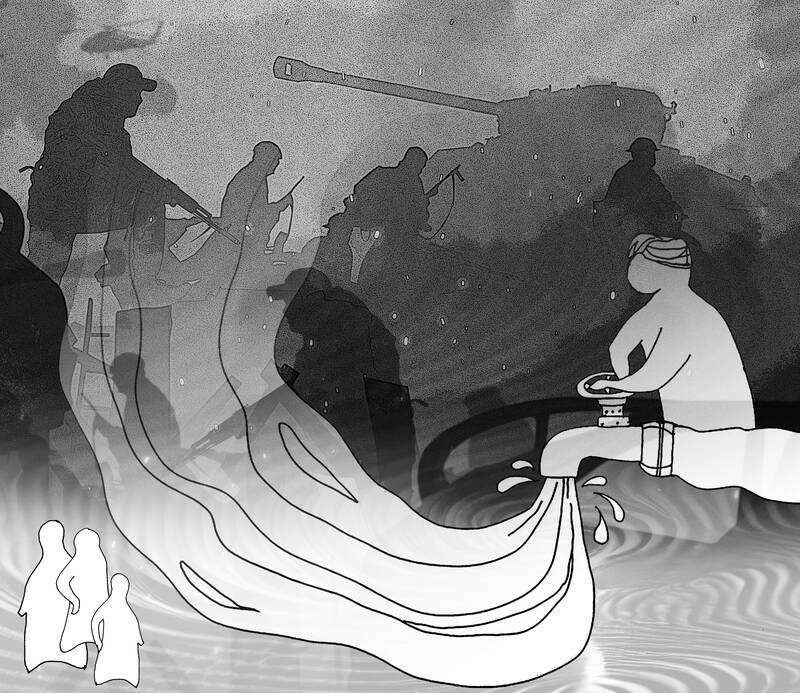Last month, Islamist gunmen — two of whom have been identified as Pakistani nationals — slaughtered 26 civilians in the Indian-administered part of divided Kashmir. It was a brutal attack, in which Hindu tourists, including one from Nepal, were singled out for slaughter. And yet, it was not surprising: Terrorist groups have long operated freely from Pakistani soil, with the tacit or explicit support of Pakistan’s powerful military.
What might be different this time is that India might have finally found a way to push back, including through military strikes on Pakistani terror camps — strikes that Indian officials said were “measured, responsible and designed to be non-escalatory in nature.” Despite the risks of tit-for-tat retaliation, India, as the stronger side, could escalate or de-escalate the conflict to its advantage.
However, the threat India faces is not coming from Pakistan alone. China has consistently provided diplomatic and strategic cover for India’s terrorism-sponsoring neighbor. For example, China’s government has repeatedly blocked UN sanctions against top Pakistani terrorists. After the latest attack, it praised Pakistan’s counterterrorism efforts, calling the country an “all-weather” strategic partner. The enemy of China’s enemy is its “ironclad friend.”

Illustration: Tania Chou
That leaves India wedged between two closely aligned nuclear powers, both of which claim sizeable swaths of Indian territory. Recent crises — from brutal Pakistani terror attacks to brazen Chinese land grabs in the Doklam and Ladakh regions — have highlighted just how acute a threat the Sino-Pakistani strategic axis poses to India.
During his 11 years in power, Indian Prime Minister Narendra Modi largely maintained a reactive security posture toward China and Pakistan, with little strategic deterrence to be seen. The Sino-Indian military standoff that was triggered in 2020 by Chinese encroachments on India’s Ladakh borderlands still has not been fully resolved.
However, this time, Modi has offered a calibrated and impactful response, pausing the Indus Waters Treaty (IWT), the world’s most-generous water-sharing pact, which grants downstream Pakistan access to more than 80 percent of the Indus Basin waters. Brokered in 1960 by the World Bank, the IWT has long been hailed as a model of cross-border cooperation — one that China has not emulated. (Although its 1951 annexation of the water-rich Tibetan Plateau gave it control over the headwaters of Asia’s major rivers, China has refused to enter into a water-sharing treaty with any of its 18 downstream neighbors.)
However, treaties are built on mutual trust and good faith — or, as the IWT’s preamble puts it, “a spirit of goodwill and friendship.” While India has steadfastly adhered to the treaty for 65 years — even when it meant compromising development in its water-stressed regions — Pakistan has consistently acted in bad faith. For example, it has used the treaty’s dispute-resolution mechanisms to drag India repeatedly into international arbitration over minor engineering differences and obstruct India’s ability to use its rightful share of water. Last year, when India formally sought to update the IWT — to account for unanticipated fac tors such as climate change, groundwater depletion and population growth — Pakistan refused to negotiate.
Meanwhile, Pakistan has waged what is effectively a proxy war by terrorism against India. The 2008 Mumbai massacre, in particular, is still etched in India’s national memory. In fact, the latest killings occurred shortly after the US extradited a key Mumbai plotter to India. Pakistani Chief of the Army Staff Asim Munir recently fanned the flames of conflict by urging Pakistanis to teach their children that Muslims are “different from Hindus in every possible way.”
International law is clear: When a treaty’s fundamental conditions collapse, or one party persistently contravenes them, the other party has the right to suspend or withdraw from the agreement. For now, India has stopped short of blowing up the IWT, instead placing the treaty “in abeyance,” a term undefined in international law. Modi has thus retained strategic ambiguity, while sending a resolute message: Resource-sharing comes with conditions. That is a warning, not a rupture.
To be sure, Pakistan claims that suspending the IWT amounts to an “act of war,” and has retaliated by suspending all bilateral agreements, including the 1972 Simla treaty, which governs peaceful dispute resolution. However, that response not only ignores the reasons for India’s decision; it also misrepresents the impact.
India is halting data sharing, design approvals and inspections under the IWT, while opening the way for actions that Pakistani objections have obstructed, such as reservoir flushing and the desilting of riverbeds. However, it is not disrupting current water flows. In fact, India does not have the infrastructure to divert the major rivers flowing to Pakistan, and its storage capacity on those rivers is negligible. So, while India is imposing costs on Pakistan, in an attempt to hold its leaders accountable for state-sponsored terrorism, it is not punishing the Pakistani people.
The six rivers of the Indus Basin have sustained local civilizations for millennia, and they can continue to do so. However, no country could be expected to uphold a peacetime treaty while experiencing the consequences of an undeclared war. If Pakistan does not want India to turn off its taps by building new hydrological infrastructure, it must demonstrate a verifiable commitment to peace, arrest terrorist leaders, shut down terrorist training camps and end its support for cross-border violence.
Brahma Chellaney, professor emeritus of strategic studies at the New Delhi-based Center for Policy Research and fellow at the Robert Bosch Academy in Berlin, is the author of Water, Peace, and War: Confronting the Global Water Crisis.
Copyright: Project Syndicate

China has not been a top-tier issue for much of the second Trump administration. Instead, Trump has focused considerable energy on Ukraine, Israel, Iran, and defending America’s borders. At home, Trump has been busy passing an overhaul to America’s tax system, deporting unlawful immigrants, and targeting his political enemies. More recently, he has been consumed by the fallout of a political scandal involving his past relationship with a disgraced sex offender. When the administration has focused on China, there has not been a consistent throughline in its approach or its public statements. This lack of overarching narrative likely reflects a combination
Behind the gloating, the Chinese Nationalist Party (KMT) must be letting out a big sigh of relief. Its powerful party machine saved the day, but it took that much effort just to survive a challenge mounted by a humble group of active citizens, and in areas where the KMT is historically strong. On the other hand, the Democratic Progressive Party (DPP) must now realize how toxic a brand it has become to many voters. The campaigners’ amateurism is what made them feel valid and authentic, but when the DPP belatedly inserted itself into the campaign, it did more harm than good. The
For nearly eight decades, Taiwan has provided a home for, and shielded and nurtured, the Chinese Nationalist Party (KMT). After losing the Chinese Civil War in 1949, the KMT fled to Taiwan, bringing with it hundreds of thousands of soldiers, along with people who would go on to become public servants and educators. The party settled and prospered in Taiwan, and it developed and governed the nation. Taiwan gave the party a second chance. It was Taiwanese who rebuilt order from the ruins of war, through their own sweat and tears. It was Taiwanese who joined forces with democratic activists
Chinese Nationalist Party (KMT) Chairman Eric Chu (朱立倫) held a news conference to celebrate his party’s success in surviving Saturday’s mass recall vote, shortly after the final results were confirmed. While the Democratic Progressive Party (DPP) would have much preferred a different result, it was not a defeat for the DPP in the same sense that it was a victory for the KMT: Only KMT legislators were facing recalls. That alone should have given Chu cause to reflect, acknowledge any fault, or perhaps even consider apologizing to his party and the nation. However, based on his speech, Chu showed